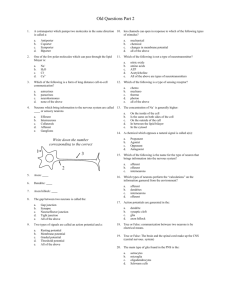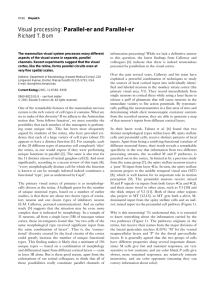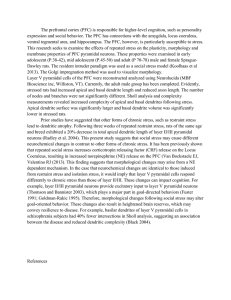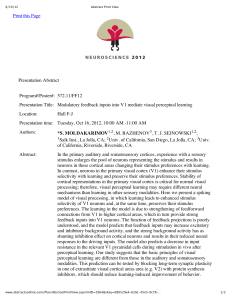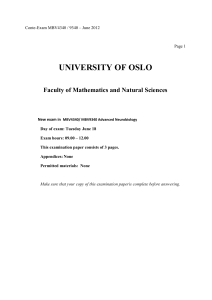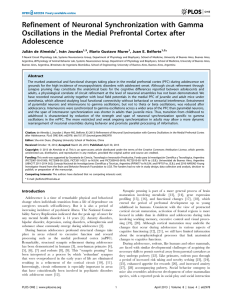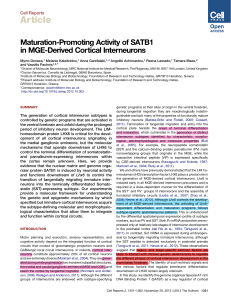fMRI: Biological Basis and Experiment Design Lecture 2 • Pretest results
advertisement
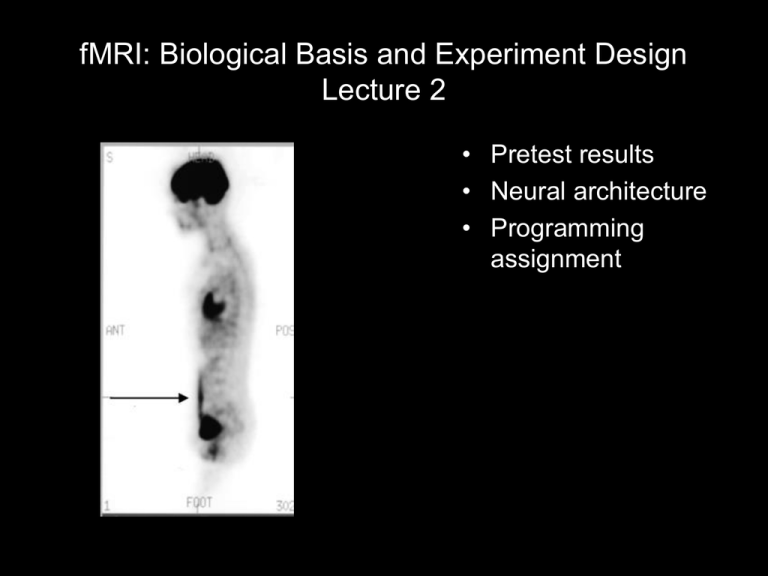
fMRI: Biological Basis and Experiment Design Lecture 2 • Pretest results • Neural architecture • Programming assignment Pretest results The brain uses 20% of consumed glucose in adults; 50% in children. Adult (showing scar tissue following hernia repair) Pediatric patient (with fungal infection of liver) 18-FDG PET images from Abouzied et al. (2005). J. Nuc. Med. Tech. 33(3):145 Neurons based on Ch. 3, Zigmund et al. Fundamentals of Neuroscience An example of cortical architecture/circuit 1. 2. 3. 4. 5. Thalamic afferent Cortical efferent Cortico-cortical eff. Thalamic afferent Cortico-thalamic eff. http://137.222.110.150/calnet/mcortex/page2.htm Layers: cortical and vascular from Fonta & Imbert, Vascularization in the primate visual cortex during development. Cer. Cortex 12:199-211 brown = cytochrome oxidase (neurons); blue = alkaline phosphatase (endothelial cells) neurons blood vessels Basic neuron behavior • Dendriditic input EPSPs • Integration • Propagation Action potentials • Synapse (neurtransmitter concentration in synaptic cleft) Neuron types (neocortex) • Pyramidal – output cells – location: • • • – • Size: giant p. neurons can have dendritic arbors 2mm across Spiny stellate: excitatory interneurons (only other spiny neuron, aside from pyramidal) – – • Location: IV, mostly in primary sensory; intrinsic axonal targets with radial organization; link IV with III, V, and VI Size: small – dendritic arbor contained w/in layer Basket, chandelier and double bouquet: inhibitory interneurons (regulate pyramidal cell function) – Locations • • Layer II and III cells are small, with restricted dendritic trees and axonal collaterals to neighboring cortical domains; Layer III and V are medium-to-large with more extensive dendritic trees and long corticocortical cxns; Layer VI exhibit greater morphologic variability and extend to corticothalamic Basket: III and V; Chandelier III (can shut down pyramidal); ... "Clutch" cell: driven by thalamus and targets spiny stellate interneurons Images taken from http://huanglab.cshl.edu/gallery.html, www.albany.edu/neuron/summer/ Neuroglia • Oligodendrocytes make myelin (Schwann cells in the peripheral nervous system) • Astrocytes – Connected by gap junctions – intracellular calcium waves – Contribute to angiogenesis – Source of extracellular matrix proteins and adhesion molecules – Source of growth factors – Housekeeping at synaptic clefts (glutamate cycling) • Microglia: CNS immune response Images taken from www.cytochemistry.net/.../membrane_intro.htm and www.bergleslab.com/research.html images from Nedergaard et al, “New Roles for Astorcytes …”, Trends in Neuroscience 26(10:523 Cortical computation Cortico-cortical cxns Intrinsic cxns Output: spikes Thalamic input: spikes Roll call (per mm3, in V1) • Excitatory neurons: .8 x 40,000 = 32,000 – Pyramidal cells dominate throughout – Stellate interneurons in input layers • Inhibitory interneurons: .2 x 40,000 = 8,000 – Basket, chandelier, ... • Glia (most of which are astrocytes): 38,000 • Endothelial cells = ??? Energy budget • Dendriditic input = EPSP – Restore membrane potential • Integration = EPSP – Restore membrane potential • Propagation – (in unmyelinated axons) – Restore membrane potential • Synapse = glutamate cycling and presynaptic Ca++ – Restore membrane potential Energy budgets Lennie (2003) “The Cost of Cortical Computation”, Current Biology 13:493. Attwell and Laughlin (2001) “An energy budget for signaling in the grey matter of the brain,” J. Cer. Blood Flow & Metab. 21:1133.


